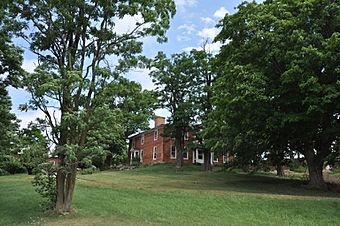Colonel Ephraim and Sarah Doolittle Farm facts for kids
Quick facts for kids |
|
|
Colonel Ephraim and Sarah Doolittle Farm
|
|
 |
|
| Location | 1 mile (1.6 km) E of VT 22A on Doolittle Rd., Shoreham, Vermont |
|---|---|
| Area | 180 acres (73 ha) |
| Built | 1766 |
| Built by | Job Lane Howe |
| Architectural style | Federal |
| MPS | Agricultural Resources of Vermont MPS |
| NRHP reference No. | 94001523 |
| Added to NRHP | January 6, 1995 |
The Colonel Ephraim and Sarah Doolittle Farm is a very old and important farm in Shoreham, Vermont. It was started way back in 1766 by Colonel Ephraim Doolittle. He was a brave soldier who fought in two big wars: the French and Indian War and the American Revolutionary War. This farm is so special that it was added to the National Register of Historic Places in 1995. This means it's recognized as a very important historical place in the United States.
What the Farm Looks Like
The Doolittle Farm covers about 180 acres of land. That's like 136 football fields! It's located in northern Shoreham. Part of the farm has woods, and a small stream called Prickly Ash Brook flows through it. The other part of the farm is open land with fields for growing crops and for animals to graze.
The main farm buildings are on the north side of Doolittle Road. The main house was built around 1800. It's a great example of an early Federal style house. This style was popular in the United States after the Revolutionary War. The house is made of brick and has a special kind of roof called a hip roof.
Besides the main house, there are other old buildings on the farm. These include a carriage barn and three barns for farm animals or crops. These barns were built in the mid-to-late 1800s. There are also a few smaller buildings.
Farm's History
Colonel Ephraim Doolittle started this farm in 1766. He was an officer in the colonial militia, which was like a local army. He helped build the Crown Point Road, which was the first road in this area. Part of that old road still runs along Doolittle Road today.
Colonel Doolittle also built a gristmill and a sawmill on Prickly Ash Brook. A gristmill grinds grain into flour, and a sawmill cuts logs into lumber. You can still see parts of their foundations today.
Doolittle was one of the first people to own land in Shoreham. He helped found the town when it was officially created in 1788. He was a very important person in the community for many years.
The main farmhouse, built around 1800, was probably constructed by Job Lane Howe. He was a well-known builder in the area. He built many other beautiful Federal style houses in the region.



